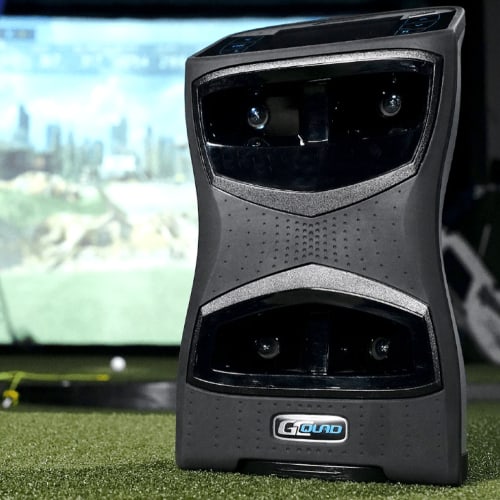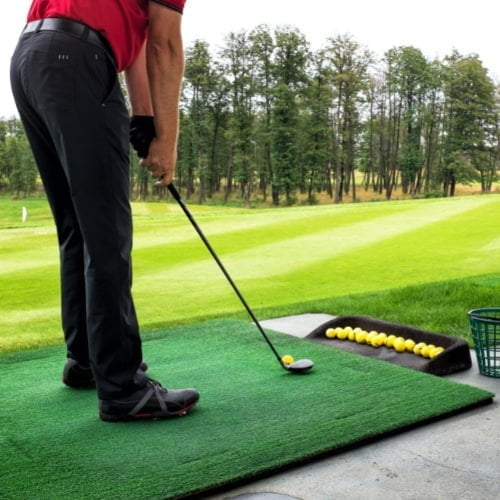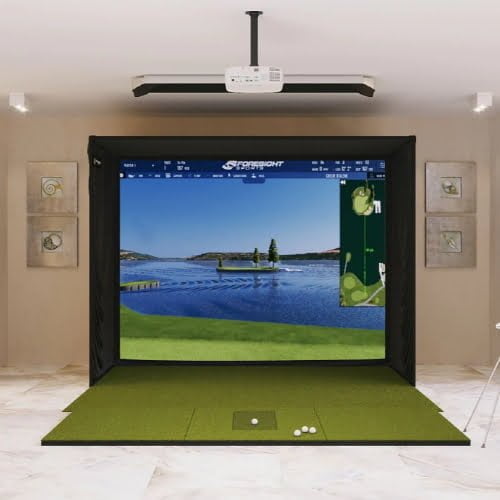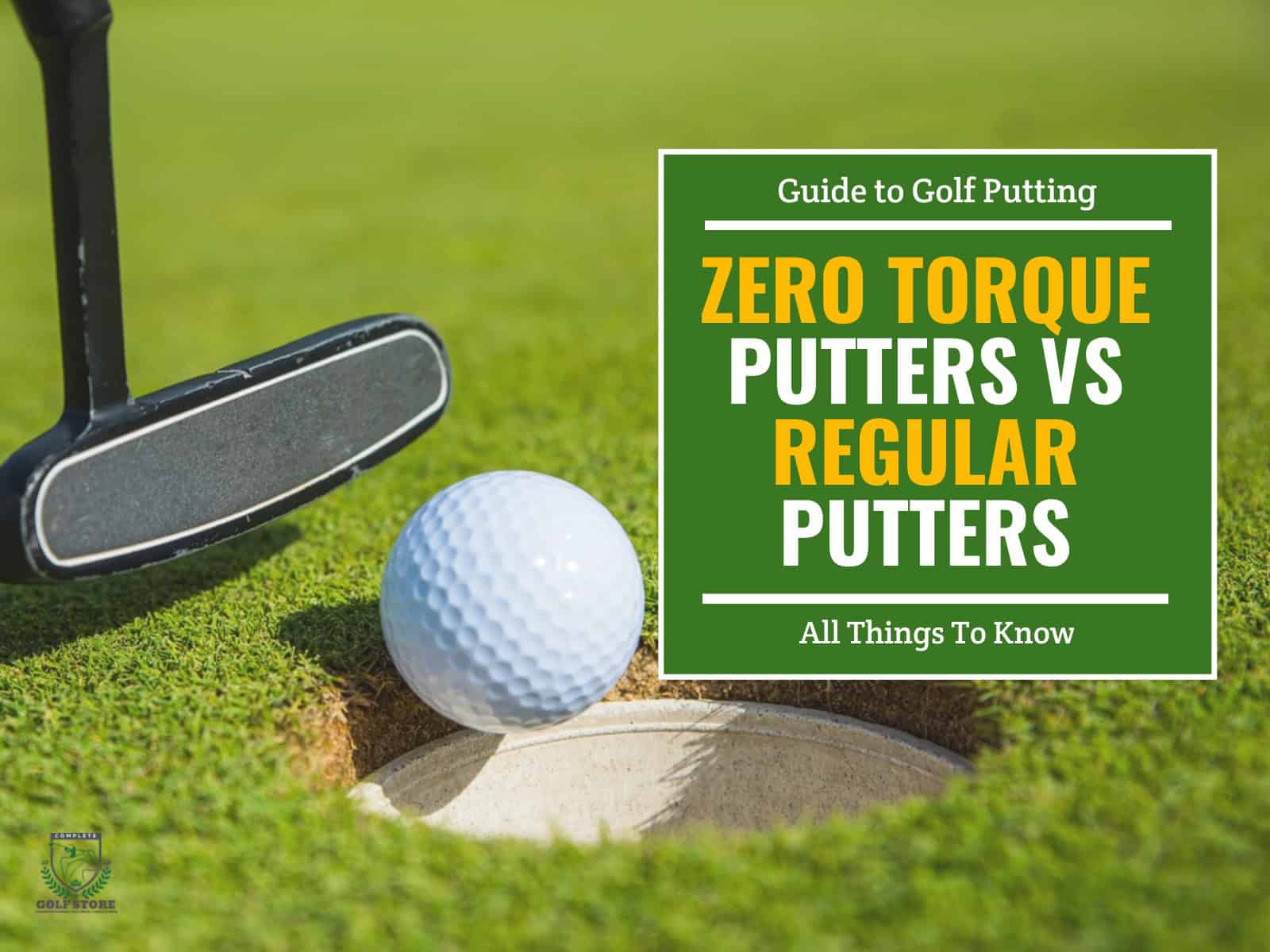Golf has been gaining popularity lately, as more and more people adopt it as their favorite pastime.
With the latest technological advancements, practicing golf has gotten even easier thanks to the technological wonders we call Golf Simulators.
The question is how beneficial is practicing on a golf simulator, compared to the driving range? The answer seems to be: both are very beneficial and useful in helping you improve your golf game and become an overall better golfer.
In this article, we will be comparing the benefits and drawbacks of driving range vs golf simulator practice to help you decide which one is better for you!
Let’s get started!
- 1) Golf Simulator vs. Driving Range: The Key Differences
-
2)
Advantages of Golf Simulators
- 2.1) Cost Saving
- 2.2) Accuracy and Realism
- 2.3) Practice with Different Clubs and Balls
- 2.4) Play for Points, Not Just Hitting Balls
- 2.5) Privacy and Comfort of Home or Indoor Golf Facility
- 2.6) Automated Instant Feedback and Game Analysis
- 2.7) Variety of Weather and Terrain Conditions to Suit the Player’s Preferences
- 3) Advantages of Driving Ranges
- 4) Disadvantages of Golf Simulators
- 5) Disadvantages of Driving Ranges
- 6) The Bottom Line
Golf Simulator vs. Driving Range: The Key Differences

When it comes to practicing your golf game, you can either play a round of golf on a course or spend time at a driving range or on a golf simulator. While both options provide their own set of advantages and disadvantages, here we’ll specifically focus on the key differences between a golf simulator and a driving range.
The first key difference is the location itself; while the range is an actual physical location you can go to and practice, a simulator creates a virtual environment for the same purpose.
Also, while both solutions mostly focus more on your long-shot practice, a sim allows for more variety and even short-game practice (chipping & putting). The driving range is solely intended for driving practice.
Additionally, a golf sim is a more convenient option with the possibility to practice indoors any time, while the range requires a trip and booking a time for practice, which sometimes might not be possible, especially with popular crowded ranges.
In the upcoming sections of this article, we will dive deeper into the differences between the two practice options!
Advantages of Golf Simulators

Golf simulators have become increasingly popular among players looking to improve their game, especially during inclement weather conditions.
Below is a list of the major advantages a virtual golf system offers over the driving range:
Cost Saving
While driving ranges are a great option (financially speaking), they may not be the most cost effective in the long term. Investing in a golf simulator can actually save you money in the long run.
Initially, the cost of purchasing a golf simulator may be higher than that of a single driving range session. However, a simulator eliminates the need for continual payments for each visit to the driving range. The result is significant cost savings in the long term.
Furthermore, many simulators offer financing options, including monthly payments, to fit into any budget. Paying over an extended period of time makes the initial financial investment less significant.
Accuracy and Realism
In terms of accuracy, golf simulators have come a long way thanks to the advancement of golf launch monitor technology. Compared to traditional driving ranges, simulators can provide more comprehensive data on ball flight, club speed, and launch angle, among other things. This data is gathered through the use of Doppler Radar (1) and/ or photometric (2) technologies, which are commonly combined with infrared sensors for the most accurate data possible.

The tracked data is then processed by sophisticated software algorithms that can analyze and display information like ball flight trajectory and distance.
To create a more realistic golfing experience, high-end simulators typically include several key components. One essential component is the impact screen, which displays the virtual golf course and feedback on the golfer’s shots. The size and aspect ratio of the screen can greatly influence the realism of the simulation. Another critical component is the projector, which should be capable of displaying an accurate and vibrant image while minimizing lag or latency.
Other components of a high-quality simulator include a sophisticated golf launch monitor and simulation software, powerful processing hardware, and an immersive audio system. These features all contribute to a more realistic overall experience that replicates the feel of playing on a real-world golf course.
Practice with Different Clubs and Balls
One of the biggest advantages of practicing with a golf simulator is the ability to use different clubs and balls, thus enabling a more versatile practice routine. Being able to practice with a variety of clubs and balls can help improve a golfer’s distance management, shot shape, and short game.

Using different clubs such as drivers, woods, irons, wedges, and putters can provide you with a better understanding of how each club performs in diverse situations. Practicing with different clubs can help you develop a feel for each club’s unique characteristics, allowing you to make better club selections during an actual game of golf.
Similarly, practicing with different golf balls can also prove to be beneficial as different balls may affect a player’s shot trajectory and distance. By practicing with diverse types of balls, you can better understand how each ball reacts when hit with specific clubs. This type of practice can be incredibly useful when facing different course conditions where winds, obstacles, or different terrain may affect ball flight.
Play for Points, Not Just Hitting Balls
Simply hitting balls on a simulator can get monotonous after a while, leading to a loss of motivation and interest. One effective way to spice things up and add a competitive aspect to your practice sessions is by playing for points.
Playing for points on a golf simulator involves utilizing various game modes or point systems that can be programmed into the simulator’s software. These game modes can range from simple stroke play, where the goal is to complete each hole in as few shots as possible, to more complex point systems like match play, skins game, and closest-to-the-pin challenges.
Playing for points on a golf simulator can be an excellent way to add a competitive aspect to your practice sessions and improve your overall game. With a wide variety of game modes and point systems to choose from, there is no shortage of ways to make your simulator practice sessions more engaging and enjoyable.
Privacy and Comfort of Home or Indoor Golf Facility

Practicing golf in the privacy and comfort of your own home or an indoor facility allows you to fully concentrate on your game without distractions, and it’s also more convenient as you can practice anytime without worrying about the weather or driving to the range.
With a personal simulator, you can also play alone or with a small group of friends or family members, which is much more convenient and quieter than playing on a crowded and noisy driving range.
Automated Instant Feedback and Game Analysis
One of the most significant advantages of golf simulators is the instant feedback they provide on your golf swing. With advanced high-speed cameras, Doppler radar, optical sensors, and infrared sensors, these simulators can track every aspect of your shot, from the ball speed and launch angle to the spin rate and shot direction.
This shot data is then analyzed by powerful software that provides useful insights into your game, highlighting areas for improvement and suggesting strategies to enhance your performance. You can see all this data on the simulator screen right after you take a shot.
By analyzing this data, you can understand where your swing path may need improvement and how to adjust for it. You can identify your strengths and weaknesses and adjust your strategy accordingly. This automated feedback makes it easy to focus on improving your game and setting realistic goals for yourself.
If you’re interested in learning more about how golf simulation systems work, check out our article here.
Variety of Weather and Terrain Conditions to Suit the Player’s Preferences

One of the most significant advantages of golf simulators over traditional driving ranges or outdoor courses is the ability to adjust a variety of weather conditions to suit your preferences. Unlike outdoor courses where the weather is uncontrollable, golf simulators allow you to play in nearly any weather condition imaginable.
Whether you prefer sunny and calm weather or want to practice in rainy and windy conditions, golf simulators have you covered. This feature alone enables you to practice in environments that suit your preferences, making it possible to work on weaknesses and improve your game year-round.
Golf simulators also provide different types of terrain, such as sandy beaches or mountainous courses, further adding to the diverse range of preferences that players may have. Being able to practice on these terrains in different weather conditions can be highly beneficial to your game, allowing you to prepare for various scenarios that you may encounter on an outdoor course.
Advantages of Driving Ranges

Driving ranges have their own set of advantages that make them a popular choice for golfers of all levels. They can be a convenient and cost-effective way to refine your skills. Let’s explore the advantages of driving ranges and why they might be a good option for some golfers.
Ability to Practice Long Distances and Various Shots
Driving ranges offer the opportunity to shoot over long distances, which is useful, especially for amateur players in honing their striking and shot-shaping skills. By utilizing these ranges, you can learn how to hit shots that take the most advantage of the long-range and keep them inside the fairway.
Most driving ranges offer a diverse range of distances with targets placed at varied lengths to simulate the challenges you may encounter on a course. This helps in training and perfecting your swing by carefully monitoring how you release the golf club at impact with the ball. This allows you to adjust and refine your swing mechanics to produce the right trajectory, enabling you to hit shots straight and far.
In addition, you can practice various shots at different trajectories, including high and low and the right and left sides of the target to improve your game. These types of exercises help you hit different shots that will come in handy on the real course. For instance, hitting a low draw or fade shot can be useful while playing on the course, depending on the conditions and layout.
Varied Terrain Options for Different Types of Lies

In some driving ranges (not all), you are able to hit the ball from different types of lies and practice hitting from varied terrain options that simulate the different types of lies you may encounter during a round of golf.
Some driving ranges have hilly or sloped terrain, which allows you to practice hitting from uphill, downhill, and sidehill lies. With uphill lies, you must adjust your stance and swing to account for the uneven surface and prevent the ball from curving to the left. With downhill lies, you need to maintain your balance and swing smoothly, as a hurried swing can cause the ball to fly off-target. Sidehill lies require you to adjust for the slope and hit the ball at an angle to compensate.
Driving ranges with sand traps or even water hazards offer the opportunity to practice hitting from tricky lie types. Hitting from a bunker is a skill that requires precision and practice, and these ranges provide golfers with an opportunity to hone their skills.
It is worth noting that while some ranges do offer different lies and terrain variations and allow for varied practice conditions, the majority only allow you to hit from a flat fixed position.

Driving ranges are typically located in easily accessible areas such as inner-city districts and suburbs, making them convenient for golfers to visit. Because they are located in such accessible locations, they offer an ideal destination for golfers to socialize, network, learn some tips and tricks, and showcase their golf skills.
The social atmosphere at driving ranges is exceptional because golfers get to interact with other enthusiasts that share the same passion. They get to meet new people, make friends, and even find potential business partners or colleagues with whom they can network. This social aspect is especially crucial for beginners, who get to learn from more experienced golfers and gain valuable insights into the game.
Disadvantages of Golf Simulators

While there are undeniable benefits to golf simulators, such as the wide variety of famous courses, from Pebble Beach to Torrey Pines, and the convenience of practicing indoors, there are also some potential drawbacks that prospective buyers should be aware of.
- Lack of Physical Activity: One of the most significant disadvantages of indoor golf simulators is the lack of physical activity involved, compared to an actual course. Unlike visiting a course or driving range, where players can walk around and get exercise while practicing their swings, using a simulator requires minimal movement. This means that golfers who primarily rely on simulators for their practice may not be getting the same amount of physical activity as those who visit a course regularly.
- Higher Initial & Ongoing Expenses: Another factor to consider is the cost of setting up and maintaining a golf simulator. While some affordable home golf simulators are available, the more sophisticated and immersive golf simulator setups can cost thousands of dollars. Maintenance costs, such as replacing worn-out mats or screens and upgrading software or hardware, can also add up over time.
- Technical glitches and inaccuracies are also potential drawbacks of using a golf simulator. While most modern simulators provide accurate data on ball speed, club path, and launch angles, occasionally, there may be technical errors or glitches that affect the accuracy of the information provided.
- Realism & Feel: While many simulators come with hundreds of virtual golf courses to choose from, the ability to accurately replicate certain shots or weather conditions may be difficult to achieve. For example, simulators may have difficulty replicating the feel of hitting a shot on a sandy beach or in high winds. More advanced hitting mats offer life-like feel and comfort, but they are usually included with premium golf simulator packages that may be out of budget for most golfers.
Disadvantages of Driving Ranges

The following are some drawbacks of practicing on a golf driving range:
- Limited shot selection at most driving ranges: While it’s possible to practice your drives, chips, and putts, it can be more challenging to work on less common golf shots, such as a low punch or a flop shot.
- Lack of course simulation: While you can practice your golf swing mechanics and ball flight, you won’t get the same experience as you would on an actual golf course. This can impact your ability to develop course management skills and adjust to different playing conditions, such as sloping fairways or tricky greens.
- Lack of Feedback: Even though you can see where your shots are landing, it can be challenging to get automated feedback on key metrics like ball speed, club path or carry distance. Without this information, it may be more difficult to identify areas for improvement and track your progress over time.
- Weather Dependency: Driving ranges are exposed to weather conditions. Inclement weather, such as rain, strong winds, or extreme heat, can limit or disrupt practice sessions. You may need to adjust your plans or find alternative practice options when weather conditions are unfavorable.
- Crowded or Noisy Environment: Popular driving ranges can become crowded, particularly during peak hours or on weekends. This may result in limited space to practice, longer wait times for hitting bays, and a potentially noisy environment. The noise and distractions can affect concentration and focus during practice sessions.
- Lack of Privacy: Driving ranges are often open and public spaces, which means there may be a lack of privacy during practice sessions. Some golfers may prefer a more secluded and private environment for practice.
The Bottom Line
Choosing between a golf simulator and a driving range ultimately depends on your individual needs as a golfer. Each option has its own unique advantages and disadvantages to consider.
Choosing one option over the other depends on things like personal preferences and budget. Ultimately, determining your goals and considering factors like cost, convenience, and practice style will help you make the best decision.
We did our best to expose the topic at hand in as much detail as possible, but if you still have questions or comments, feel free to contact us.
Thanks for reading!
References:
- What is Doppler Radar? – Definition & Uses. https://study.com/academy/lesson/what-is-doppler-radar-definition-uses.html
- Photometry. https://www.sciencedirect.com/topics/chemistry/photometry





